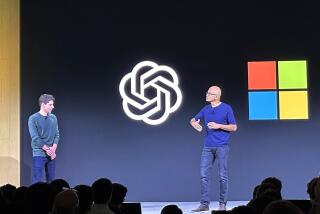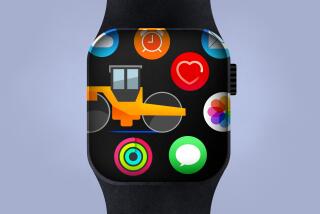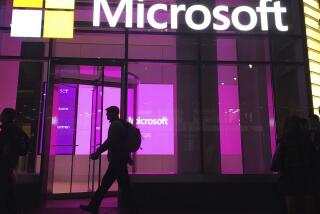Softwareâs Big Fish May Catch Piece of Net
Microsoft Corp.âs purchase of a stake in Apple Computer isnât a big deal in money terms, but the startling transaction and investorsâ enthusiasm for it stand as a poetic symbol of Microsoftâs growing hegemony all across the computer world.
Microsoftâs Windows long ago had won the competition with Appleâs Macintosh to supply the operating system--the basic software instructions--for personal computers. Buying a piece of Apple now will bolster Microsoftâs efforts in the infant and wide-open field of the Internet, and help it beat back Internet darling Netscape Communications.
And the Apple deal could also indirectly help Bill Gates and his troops win a ferocious war for the loyalty of the businesses and engineers that use computers far more powerful than the typical PC.
For the Microsoft of today is much more than a vendor of personal computer software. Itâs an influential presence in nearly every important part of the burgeoning computer world, and aims to occupy a similar position in key parts of the communications business. Increasingly, itâs willing to spend its $9-billion cash hoard to buy companies and technologies that can advance those goals.
To be sure, Microsoftâs continued success as computing combines with telecommunications and evolves in the Internet age may not be certain. But the company and its chairman, William H. Gates III, are favorites at this point.
Bill Gates, the 42-year-old founder and owner of almost 24% of his companyâs stock--a stake worth more than $40 billion--is a big reason behind Microsoftâs success. âBig companies make strategic decisions by compromise, the sandpaper makes everything smooth,â says a former top executive of a major company.
âBut Bill Gates makes his own decisions, tells people, âWe have to do this.â And heâs betting his own money,â the executive says.
Gates is not so much an innovator as a ferocious adapter and competitor. He sees the way the wind blows and marshals resources to grind out victory.
For example, Steve Jobs, the founder of Apple, led the commercialization of an easy-to-use operating system--one that used graphical symbols and a pointing device called a mouse--first in a system called Lisa, and then successfully in the Macintosh.
But Microsoft adapted the âgraphical interfaceâ technology to create Windows, a fact it tacitly admitted Wednesday when it settled a long-running patent infringement suit with Apple. Through shrewd marketing and understanding of the needs of emerging PC manufacturers, it eventually relegated Apple to a mere market niche.
With its Windows NT operating system, Microsoft hopes to do something similar to the operating systems that now guide workstations made by Sun Microsystems and Hewlett-Packard. The way Gates developed NT illustrates the Microsoft method and indicates the computer industryâs direction in the years ahead.
Complex operating systems like NT allow users to perform multiple tasks simultaneously without overloading, or âcrashing,â the computer. Such systems are used by scientists and engineers and increasingly by financial firms, which need fast, flexible and highly reliable computers.
IBM, Sun and Novell Inc. supply software for such work, most of it based on the Unix operating system, which was developed initially by AT&T;âs Bell Labs.
Gates worked with IBM in the 1980s to develop an answer to Unix, but the entrepreneur and the big company had a parting of the ways. IBM went on to develop its OS2 system. But Gates hired some of the worldâs leading programmers and put them to work devising NT, which has proven successful since its introduction in 1993.
Gates is criticized by high tech competitors as a mere adapter of othersâ innovations. But he sees more clearly than most computer wizards and Microsoft does far more than simply adapt. Right now, Gates understands that the personal computer is taking on work once done by mainframe and powerful workstation computers. Thatâs why Microsft will spend almost $2 billion this year on research and development for NT and related systems. Along with Intel, which makes the computerâs inner circuitry, Microsoft advances the computerâs capabilities.
Yet Microsoft can be nearsighted, too. It didnât see the Internet developing and those who did see that new world as a way to defeat Gates and Microsoft. Lawrence Ellison, chairman of Oracle Corp., who became an Apple director on Wednesday, maintains that the Internet will soon make personal computers, and Microsoft software, unnecessary.
In Ellisonâs vision, applications software will be available on the Internet and computer users will get access to them with a simple, $500 network access machine.
But Gatesâ view is that access to those Internet applications--when such systems become practicable--will still depend on a Windows operating system. Wednesdayâs Apple deal will help him ensure Microsoftâs place on the Internet because Apple will provide a new outlet for Microsoftâs Web browser.
And Appleâs software skills will help Microsoft develop an Internet computer language to compete with Sunâs Java product.
As before, Microsoft wonât be the innovator, but it could be the prevailing competitor.
For the future, which will see further combining of computing and telecommunications, Gates is making investments in Comcast, a cable television company, and WebTV.
Questions arise. Microsoft, a 22-year-old company, has grown extremely fast in recent years, more than doubling sales and trebling profits since 1994. It is now a sizable company with 20,561 employees and $11.4 billion in sales.
It also has virtual monopolies in many of its markets.
Can it keep those employees motivated and avoid becoming a bureaucratic big company? And how long can it avoid antitrust action from the federal government? So far, a sharply rising stock has handled the motivation and adroit negotiation has dealt with antitrust inquiries. But the questions will continue as long as Microsoft, like IBM and even Apple before it weakened, achieves a growing leadership of the world computer industry.






